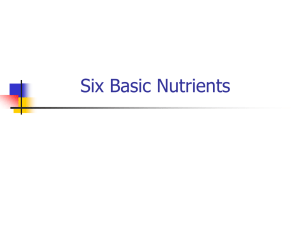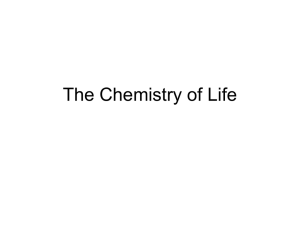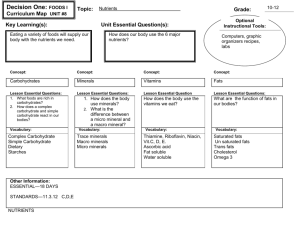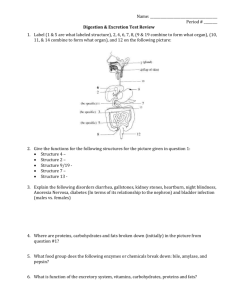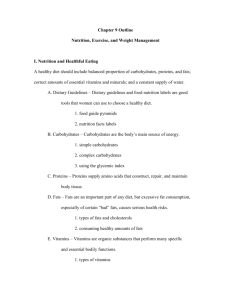PowerPoint to accompany Hole's Human Anatomy and Physiology
advertisement
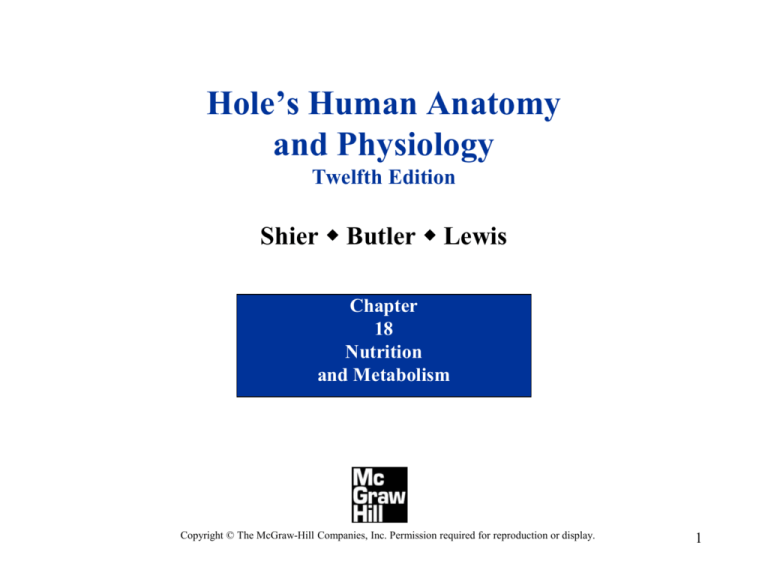
Hole’s Human Anatomy and Physiology Twelfth Edition Shier w Butler w Lewis Chapter 18 Nutrition and Metabolism Copyright © The McGraw-Hill Companies, Inc. Permission required for reproduction or display. 1 18.1: Introduction • The human body requires fuel as well as materials to develop, grow and heal • Nutrients are chemical substances supplied by the environment required for survival • Macronutrients • Carbohydrates • Proteins • Fats • Micronutrients • Vitamins • Minerals • Essential nutrients • Nutrients human cells cannot synthesize such as certain amino acids 2 3 Copyright © The McGraw-Hill Companies, Inc. Permission required for reproduction or display. Release into bloodstream Bloodstream Stimulation Inhibition Adipocytes synthesize fat and secrete leptin into bloodstream + Leptin increases metabolic rate. + Fat cells – Leptin inhibits neuropeptide Y release from the hypothalamus Food intake in excess of caloric needs excessive Appetite suppressed – Appetite + insufficient Fasting Appetite enhanced Ghrelin stimulates release of neuropeptide Y from the hypothalamus + + Cells in stomach secrete ghrelin Bloodstream 4 18.2: Carbohydrates • Carbohydrates are organic compounds and include the sugars and starches • The energy in their chemical bonds are used to power cellular processes • Excesses lead to: • Obesity • Dental caries • Nutritional deficits • Deficiencies lead to: • Metabolic acidosis • Weight loss 5 Carbohydrate Sources • Carbohydrates are ingested in a variety of forms: • Complex carbohydrates are polysaccharides that include: • Starch from plant foods • Gylcogen from meats • Simple carbohydrates are: • Dissaccharides from milk sugar, cane sugar, beet sugar and molasses • Monosaccharides from honey and fruits • Digestion breaks complex carbohydrates into monosaccharides that are small enough to be absorbed • Cellulose is a complex carbohydrate abundant in our food • It is not digested, but provides bulk (fiber or roughage) 6 Carbohydrate Use • Monosaccharides that are absorbed include fructose, galactose, and glucose Copyright © The McGraw-Hill Companies, Inc. Permission required for reproduction or display. Carbohydrates Starch Sucrose Maltose Lactose Digestion Glucose Glucose and Fructose Glucose Glucose and Galactose Monosaccharides (Respiration) (Glycogenesis) (Lipogenesis) CO2 + H2O + Energy Glycogen Fat 7 Carbohydrate Requirements • The minimal requirements for carbohydrates in the human diet is unknown • Intake of at least 125 – 175 grams is necessary • An average diet includes 200-300 grams 8 18.3: Lipids • Lipids are organic compounds that include fats, oils, and fatlike substances such as phospholipids and cholesterol • They supply energy for cellular processes and help to build structures like cell membranes • The most common dietary lipids are fats called triglycerides • Excesses lead to: • Obesity • Increased serum cholesterol • Increased risk of heart diseases • Deficiencies lead to: • Weight loss • Skin lesions • Hormonal imbalances 9 Lipid Sources • Triglycerides are found in plant-based and animal-based foods and include: • From plants: • Seeds, nuts and plant oils (olive, peanut and canola are the healthiest) • From animals: • Meat, eggs, milk and lard 10 Lipid Use • Lipids in foods are phospholipids, cholesterol and most commonly, fats (triglycerides) • They are oxidized for energy • They are stored in adipose tissue • Glycerol may be used to synthesize glucose 11 Copyright © The McGraw-Hill Companies, Inc. Permission required for reproduction or display. Fats from foods Hydrolysis Glucose Glycerol Fatty acids + Fat Ketone bodies Beta oxidation Acetyl coenzyme A Citric acid cycle Energy + CO2 + H2O 12 ATP Heat Copyright © The McGraw-Hill Companies, Inc. Permission required for reproduction or display. Triglycerides Digestion Fatty acids + Glycerol Triglycerides Lipoproteins Fatty acids (except essential fatty acids) Cholesterol Phospholipids 13 Lipid Requirements • The lipid content of human diets varies widely • The American Heart Association advises that the diet not exceed 30% of total daily calories from fat 14 18.4: Proteins • Proteins are polymers of amino acids • They have a wide variety of functions, including building more protein (structural protein, enzymes, hormones, and plasma proteins) and supplying energy • The waste product of protein metabolism is urea • Excesses lead to obesity • Deficiencies lead to: • Extreme weight loss • Muscle wasting • Anemia • Growth retardation 15 Copyright © The McGraw-Hill Companies, Inc. Permission required for reproduction or display. Protein Digestion Amino acids Proteins Energy + CO2 + H2O Structural proteins Enzymes Hormones Glucose Fat Plasma proteins 16 Copyright © The McGraw-Hill Companies, Inc. Permission required for reproduction or display. Proteins from foods Hydrolysis Amino acids Deamination Deaminated portions (by various pathways) + –NH2 groups Urea Acetyl coenzyme A Fat Glucose Citric acid cycle Energy + CO2 + H2O 17 ATP Heat Protein Sources • Foods rich in proteins include: • Meats • Fish • Poultry • Cheeses • Nuts • Milk • Eggs • Cereals • To some degree legumes (beans and peas) • The body needs 20 types of amino acids; those that can be synthesized by the body are non-essential amino acids (12) and those that cannot are essential amino acids (8) 18 Nitrogen Balance • In healthy adults, protein is continuously built up and broken down • Proteins contain a high percentage of nitrogen • The amount of nitrogen taken in is equal to amount excreted • Negative nitrogen balance develops from starvation • Positive nitrogen balance develops in growing children, pregnant women, or an athlete in training 19 Protein Requirements • In addition to supplying essential amino acids, proteins provide nitrogen and other elements for the synthesis of nonessential amino acids and certain non-protein nitrogenous substances • The dietary amount varies according to body size, metabolic rate, and nitrogen balance condition • Typically protein intake is 10% of a person’s diet • Most people should consume 60-150 grams a day 20 21 18.5: Energy Expenditures • Carbohydrates, fats and proteins supply energy for all metabolic processes • Deficiencies can lead to death • Excesses can lead to obesity 22 Energy Values of Food • A calorie indicates the amount of potential energy a food contains • Calories can be measured from the content of foods • The rate that the body expends energy can be measured and is known as basal metabolic rate (BMR) • This varies for: • Carbohydrates • 4.1 calories per gram • Lipids • 9.5 calories per gram • Proteins • 4.1 calories per gram Copyright © The McGraw-Hill Companies, Inc. Permission required for reproduction or display. Electric wires for ignition of sample Thermometer Oxygen Food sample Stirrer Platinum dish Water Insulation 23 24 Energy Requirements • Basal metabolic rate (BMR): • The rate at which body expends energy at rest • This primarily reflects energy needed to support the activities of the organs • This varies with gender, body size, body temperature, and endocrine function • Energy is needed: • To maintain BMR • To support muscular activity • To maintain body temperature • For growth in children and pregnant women 25 Energy Balance • Energy balance occurs when caloric intake in the form of food equals caloric output from BMR and muscular activities • The body weight remains constant • If, however, caloric intake exceed output, tissues store excess nutrients • This is a positive energy balance that leads to weight gain 26 Desirable Weight • Most common nutritional disorders involve caloric imbalances • Desirable weight is difficult to determine • Body Mass Index (BMI) is used today to assess weight considering height • A person is classified with BMI as either underweight, normal weight, overweight, or obese • Overweight is defined as exceeding desirable weight by 10% - 20%, or a BMI of 25 and 30 • Obesity occurs when a person is more than 20% above desired weight, or with a BMI over 30 27 18.6: Vitamins • Vitamins are organic compounds, other than carbohydrates, lipids and proteins, that are essential for normal metabolic processes • Vitamins cannot be synthesized by body cells in adequate amounts • Vitamins are classified on the basis of solubility as either fatsoluble (vitamins A, D, E, and K) or water-soluble (the B vitamins and vitamin C) 28 29 Fat-Soluble Vitamins • The fat-soluble vitamins dissolve in fats and are influenced by lipids • Bile salts promote fat-soluble vitamin absorption • They are fairly resistant to heat (not destroyed by cooking and/or food processing) • Includes vitamins A, D, E, and K 30 31 Water-Soluble Vitamins • The water-soluble vitamins include the B vitamins and vitamin C • Cooking and food processing destroy them • B vitamins (six of them) are several compounds essential for normal cellular metabolism and known as the vitamin B complex 32 33 18.7: Minerals • Dietary minerals are inorganic elements that are essential in human metabolism • These are usually extracted from the soil by plants • They are obtained by humans from plant foods or animals that have eaten plants • They are responsible for roughly 4% of body weight 34 Characteristics of Minerals • Minerals are most concentrated in the bones and teeth • They are typically incorporated into organic molecules (phospholipids, hemoglobin and iodine in thyroxine) • They compose parts of the structural materials of all cells • Homeostatic mechanisms regulate the concentration of minerals in body fluids • Mineral toxicity can result from too much of a mineral or from overexposure to industrial pollutants, household chemicals, or certain drugs 35 Major Minerals 36 Trace Elements • Trace elements (microminerals) are essential minerals found in minute amounts, each makes up less than 0.005% of body weight • They include: • Iron • Manganese • Copper • Iodine • Cobalt • Zinc • Fluorine • Selenium • Chromium 37 38 18.8: Healthy Eating • An adequate diet provides sufficient energy (calories), essential fatty acids, essential amino acids, vitamins, and minerals to support optimal growth and to maintain and repair body tissues • Requirements vary with age, sex, growth rate, level of physical activity and stress, and genetic and environmental factors • Dietary requirements such as recommended daily allowances (RDA) are best to follow • The U.S. Department of Agriculture’s Food Pyramid is another tool to follow • Nutritional information as well as ingredients are listed on 39 most grocery items for retail sale Copyright © The McGraw-Hill Companies, Inc. Permission required for reproduction or display. (a) Activity Activity is represented by the steps and the person climbing them, as a reminder of the importance of daily physical activity. Proportionality Proportionality is shown by the different widths of the food group bands. The widths suggest how much food a person should choose from each group. The widths are just a general guide, not exact proportions. Moderation Moderation is represented by the narrowing of each food group from bottom to top. The wider base stands for foods with little or no solid fats or added sugars. These should be selected more often. The narrower top area stands for foods containing more added sugars and solid fats. The more active you are, these foods can fit into your diet. MyPyramid.gov GRAINS VEGE TABLES OILS STEPS TO A HEALTHIER YOU Personalization Personalization is shown by the person on the steps and the slogan. U.S. Department of Agriculture Center for Nutrition Policy and Promotion April 2005 CNPP-16 Variety Variety is symbolized by the 6 color bands representing the 5 food groups of the Pyramid and oils. This illustrates that foods from all groups are needed each day for good health. FRUITS Gradual Improvement Gradual improvement is encouraged by the slogan. It suggests that individuals Can benefit from taking small steps to improve their diet and lifestyle each day. MEAT & BEANS MILK USDA is an equal opportunity provider and employer. (b) (c) Daily Beverage Recommendations: 6 glasses of water Sweets Olive Oil Fats Protein/Dairy Wine in moderation Carbohydrates Meat Monthly Sweets Eggs Poultry Fish Cheese & Yogurt Weekly Fruits Olive Oil Vegetables Mayo Clinic Healthy Weight Pyramid Meats Sweets Eggs and poultry Fish and shell fish or dairy Vegetable oils Whole grains & potatoes Fruits Olive oil Beans, legumes Vegetables & nuts Daily Daily Physical Activity Monthly Weekly The Mediterranean Diet Pyramid Optional daily Daily Fruits, legumes, nuts, seeds, vegetables Rice, rice products, noodles, breads, millet, corn and other grains (d) Physical activity The Asian Diet Pyramid Sake, wine, beer, other alcoholic beverages and tea 40 Malnutrition • Malnutrition is poor nutrition that results from a lack of essential nutrients or failure to use them • Undernutrition – deficiency of essential nutrients • Overnutrition – excess of nutrient intake • Malnutrition can be a result of: • Primary malnutrition – malnutrition from diet alone • Secondary malnutrition – adequate diet but individual characteristics make the diet insufficient 41 Starvation • A healthy human can survive 50-70 days without food • Symptoms include low blood pressure, slow pulse, chills, dry skin, hair loss, and poor immunity • Common nutritional disorders include: • Marasmus – lack of all nutrients • Kwashiorkor – protein starvation • Anorexia nervosa – eating disorder; self-starvation • Bulimia – eating disorder; binge and purge cycle 42 18.9: Lifespan Changes • Dietary requirements remain generally the same throughout life • BMR rises in early childhood and peaks in adolescence • BMR declines in adulthood • Change in nutrition often reflects the effects of medical conditions and the social and economic circumstances 43 Important Points in Chapter 18: Outcomes to be Assessed 18.1: Introduction Define nutrition, nutrients, and essential nutrients. Explain appetite control. 18.2-18.4: Carbohydrate - Proteins List the major sources of carbohydrates, lipids, and proteins. Describe how cells utilize carbohydrates, lipids, and proteins. Define nitrogen balance. 18.5: Energy Expenditures Explain how energy values of food are determined. Explain the factors that affect an individual’s energy requirements. Define energy balance. 44 Important Points in Chapter 18: Outcomes to be Assessed Explain what is meant by desirable weight. 18.6: Vitamins List the fat-soluble and water-soluble vitamins and summarize the general functions of each vitamin. 18.7: Minerals Distinguish between a vitamin and a mineral. List the major minerals and trace elements and summarize the general functions of each. 18.8: Healthy Eating Describe an adequate diet. Distinguish between primary and secondary malnutrition. 45 Important Points in Chapter 18: Outcomes to be Assessed 18.9: Lifespan Changes List the factors that may lead to inadequate nutrition later in life. 46

